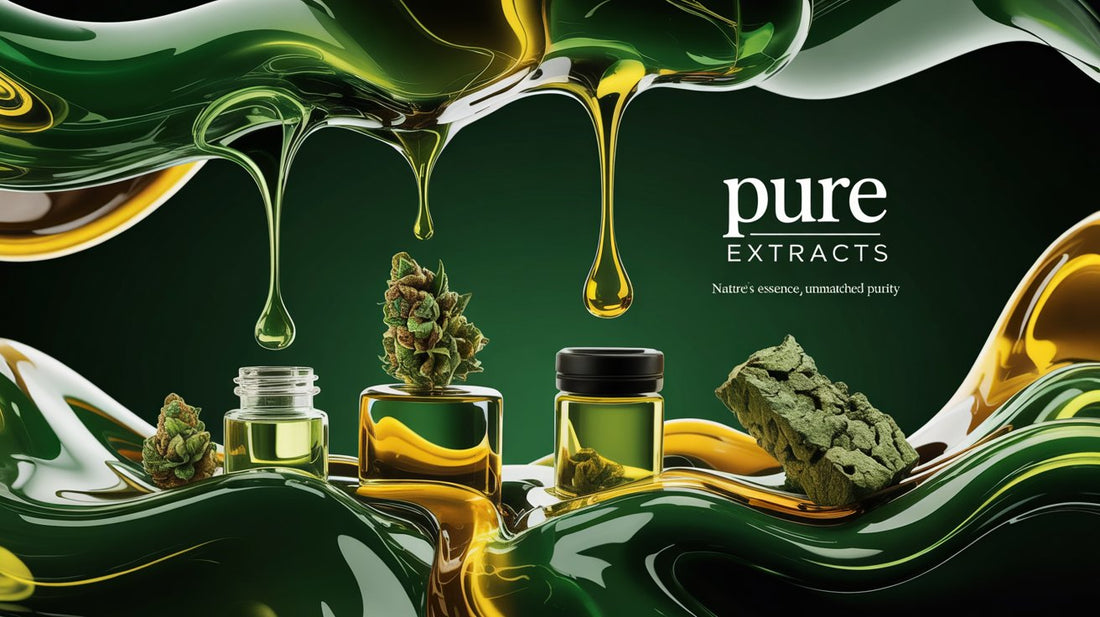
How Cannabis Concentrates Are Made: Everything You Need to Know
Share
Welcome to the world of cannabis concentrates!
Whether you're a seasoned smoker or just starting out, you've probably heard the buzz surrounding these potent products. Cannabis concentrates are becoming increasingly popular for their high THC and CBD content, which can provide users with a more intense experience than traditional smoking methods.
But how are they made? In this article, we'll delve into the process of creating cannabis concentrates and explore the different types available.
So sit back, relax, and prepare to learn everything there is to know about this exciting trend in marijuana culture!

What are Cannabis Concentrates?
Cannabis concentrates are highly potent extracts of the cannabis plant that contain a high concentration of cannabinoids, including THC and CBD. These extracts are made by separating the resin glands (trichomes) from the rest of the plant material to create a concentrated form of cannabis.
There are many different types of cannabis concentrates available on the market today, each with its own unique properties and effects. Some popular examples include:
- Shatter
- Wax
- Budder
- Crumble
- Rosin
- Oil.
To make these concentrates, producers use solvents such as butane or CO2 to extract the trichomes from the plant material. The resulting liquid is then purged of any residual solvents before being packaged for sale.
Cannabis concentrates offer several advantages over traditional smoking methods. Here are a few!
- They deliver a more potent dose of cannabinoids.
- They provide consumers with greater control over dosage levels.
- They have a less harsh smoke than traditional joints or blunts.
But let’s get into a bit more detail about the different types of cannabis concentrates and each of their benefits.

The 6 Different Types of Cannabis Concentrates
There are various types of cannabis concentrates, each with its unique characteristics. That is why we created this table with a brief description of each type of cannabis concentrate. Check it out!
| Type of Concentrate | Characteristics |
| Hash | Hash is made by pressing trichomes into a ball or cake. |
| Kief | Kief consists of resin glands that fall off the plant during handling and processing. |
| Wax | Wax is a thick and sticky consistency that can be challenging to handle due to its texture. It is also one of the most potent. |
| Shatter | Shatter has a glass-like appearance and texture and is known for its high THC content. |
| Resin | Live resin, on the other hand, involves using fresh-frozen buds instead of dried ones when extracting cannabinoids from the plant material. This method captures more terpenes than other methods because it doesn't involve drying out the buds first. |
| Oil Concentrate | Cannabis oil concentrates are also becoming more common as they're versatile and easy to use in edibles or vaporizers. They come in different forms such as CO2 oil or BHO (butane hash oil). |
There are many different types of cannabis concentrates available for consumers to try based on their preferences and desired effects. Each method offers unique flavors, aromas, textures, and cannabinoid profiles that make them worth exploring!

The Top 3 Solvents Used to Make Cannabis Concentrates
The process of making cannabis concentrates involves the use of solvents to extract THC or CBD from the plant material. Solvents are liquids that dissolve cannabinoids and terpenes, leaving behind impurities like plant wax and chlorophyll.
There are three main solvents that you should take into account. Let’s get into more detail.
Butane
One common solvent used in concentrate production is butane, which is used to make butane hash oil (BHO). Butane has a low boiling point which makes it easy to evaporate after extraction. However, butane is also highly flammable and can pose a safety risk if not handled properly.
CO2
Another popular solvent used in concentrate production is CO2. This method uses pressurized carbon dioxide to extract cannabinoids and terpenes from the plant material. CO2 extraction produces a clean product without any residual solvents or contaminants.
Ethanol
Ethanol is another commonly used solvent for making cannabis concentrates. Ethanol extracts both water-soluble and oil-soluble compounds, resulting in a full spectrum extract with high levels of THC or CBD.
The choice of solvent depends on the desired end product and personal preference. It's important to note that proper safety measures should always be taken when working with solvents during concentrate production.

The 4 Main Tools Needed to Make Cannabis Concentrates
To make cannabis concentrates, it's important to have the right equipment. There are 4 main types of equipment that can be used depending on the type of concentrate being made. Let's get into it!
Glass Extraction Tube
One of the most common pieces of equipment is a glass extraction tube, which is used for making butane hash oil (BHO). This tube allows for the solvent to pass through and extract the desired cannabinoids from the plant material.
A Vacuum Oven
A vacuum oven is another essential piece of equipment in making cannabis concentrates. This device effectively removes any remaining solvents and moisture from the concentrate, resulting in a more pure and potent final product.
Rosin Press
For those who prefer a less dangerous method than BHO extraction, rosin presses are becoming increasingly popular. These presses use heat and pressure to extract resinous oils from dried flowers or kief without using any solvents at all.
Crockpot
If you're looking to make your own edibles with concentrates, a double boiler or crock pot will come in handy for infusing butter or oil with THC or CBD extracts.
Overall, investing in quality equipment ensures safety during production and produces better results overall.

The Top 2 Methods of Making Cannabis Concentrates
The process of making cannabis concentrates involves using solvents or extraction methods to isolate the desired cannabinoids and terpenes from the plant material. There are two main methods. You can check them out in the table below.
| Method | Process |
| Butane Extraction |
One popular method is called butane hash oil (BHO) extraction, which uses pressurized butane gas to extract THC and other compounds.
|
| Rosin Pressing |
Another method for making cannabis concentrates is through rosin pressing. This involves applying heat and pressure to marijuana buds or kief using a specialized machine. This process extracts the essential oils without requiring any solvents.
|
While these methods produce potent concentrates with high levels of THC or CBD, they can also be dangerous if not done properly. It's important for individuals attempting to make their own concentrates to research safety guidelines and follow best practices carefully.
Making cannabis concentrates requires skill, patience and attention-to-detail in order to achieve a quality final product that delivers maximum potency and flavor.

Pros and Cons of Cannabis Concentrates
Cannabis concentrates offer a more potent and efficient way to consume cannabis. However, there are pros and cons to consider when using them. Here is a quick rundown of the main benefits and drawbacks that come with consuming concentrates.
| Pros of Cannabis Concentrates | Cons of Cannabis Concentrates |
| They have higher levels of THC or CBD, which can provide greater relief for medical conditions like chronic pain, anxiety, and depression. | Their potency can be overwhelming for new users who may experience unwanted side effects such as paranoia or anxiety. |
| They also offer a discreet option for consuming cannabis as they produce less odor than traditional smoking methods. | Some concentrates are made using solvents that can be harmful if not properly purged from the final product. |
Another drawback is the potential risk associated with making these products at home without proper training or equipment. This could result in an explosion or fire due to the use of flammable solvents during production.
While cannabis concentrates offer many benefits over traditional methods of consumption, it's important to weigh both sides before deciding if they're right for you.
Conclusion
Cannabis concentrates have become increasingly popular in recent years due to their potency and convenience. The process of making concentrates can vary depending on the type of concentrate being produced, the solvent used, and the equipment needed.
Although cannabis concentrates offer many benefits such as stronger effects and a more discreet method of consumption, they also come with some drawbacks such as health risks associated with certain solvents and equipment.
It’s important to do your research before trying any new product or method of consumption. Always purchase from reputable sources and consider consulting with a medical professional if you have any concerns about using cannabis products.
Cannabis concentrates are an exciting development in the world of marijuana use. As long as they are used responsibly and safely, they can provide users with a unique way to enjoy all that this amazing plant has to offer.
